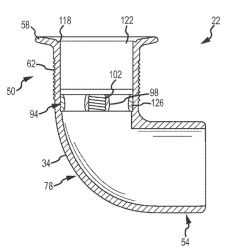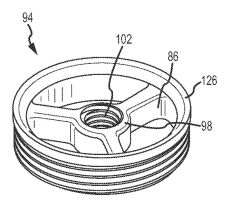Drain Fairy "Abfluss Fee" – Fresh scent for the sink
15.06.2023
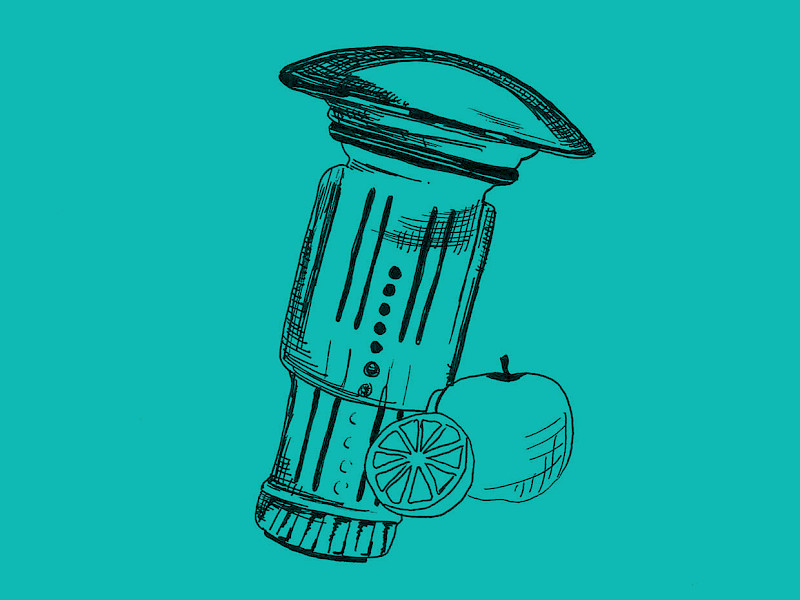
Shark Tank of Patents
In season 3, episode 2, of the TV show "Die Höhle der Löwen" (German pendant to "Shark Tank" in the US and "Dragon's Den" in the UK), a passionate inventor presents his invention, called Abfluss Fee (hereinafter Drain Fairy). The Drain Fairy is a drain plug for sinks that adds a fragrance stone with a cleaning agent to the plug. Hair and dirt are decomposed and thus can no longer accumulate in the drain. In addition, the Drain Fairy secretes a pleasant scent.
Several patent and utility model applications have been filed for the Drain Fairy. The example of a patent application for a further development of the original Drain Fairy is intended to illustrate how a change in the designation of the subject-matter of the invention per se, together with a functional indication, can lead to an inventive step.
Note: The designation of the subject-matter of the invention (the so-called preamble) indicates the subject-matter in general terms for which protection is sought for. The designation of the subject-matter of the invention is usually clearly formulated in the first words of a claim.
European patent application – EP3943677A1 (EP'77)
Subject-Matter of Protection
In EP'77, an attempt was made to protect the Drain Fairy with an independent claim 1 directed to an adapter (cf. reference signs in parentheses from the extract of Fig. 4 in EP'77). The adapter is thus the designation of the subject-matter of the invention in EP'77.
Claim 1 of EP'77 defines the following features:
M1: Adapter (20) for mounting a push-up drain valve or the like in a drain fitting of a sink, characterized in that the adapter (20) comprises
M2: an annular outer portion (21) adapted to be mounted between a downpipe projecting vertically downward from the sink and a curved trap adjacent thereto or in a downpipe projecting vertically downward from the sink, and
M3: a central portion (24) located radially inside the outer portion (21) and adapted to support the push-up drain valve or the like from below,
M4: wherein the outer portion (21) and the central portion (24) are fixedly connected to each other with water drainage space recess.
Sealing Plug
In other words, claim 1 defines an adapter having an inner portion 24 for supporting the drain valve and an outer portion 21 for connecting to a downpipe between which portions 21 and 24 water can drain.

Prior Art
Claim 1 - Lack of noverty over D1
D1 discloses, with reference to Fig. 5 and 6 of D1 (cf. [0022] in D1), a disc 56 (cf. M1) having a circumferential groove 56b (cf. M2) along its outer periphery and a central threaded bore 56a (cf. M3) that is threaded onto a lower end 54a of the pressure mechanism 54. The disc 56 is forced into a drain pipe 52, and an O-ring 58 provides friction against an inner wall of the drain pipe 52 to anchor the disc 56 and the pressure mechanism 54 in the drain pipe 52 (cf. M2). The disc 56 has openings 56c, 56d, 56e, and 56f through which water can flow and drain (cf. M4).

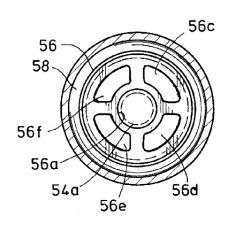
Fig. 5 and Fig. 6 of D1
Thus, the disk 56 of D1 comprises all the features M1 to M4 of claim 1 in EP'77.
Claim 1 of EP'77 is thus not novel over D1.
Lack of novelty over D2
D2 discloses, with reference to Fig. 1 of D2 (cf. [0052] to [0060] in D2), a drain element 27 (cf. M1) that can be coupled to the drain pipe 27 (cf. M2) and has a mounting hole 25 (cf. M3). Here, drain grooves 26 are arranged circularly and radially around the mounting hole 25 (cf. M4).
Thus, the drain element 27 of D2 comprises all the features M1 to M4 of claim 1 in EP'77.
Claim 1 of EP'77 is thus also not novel over D2.
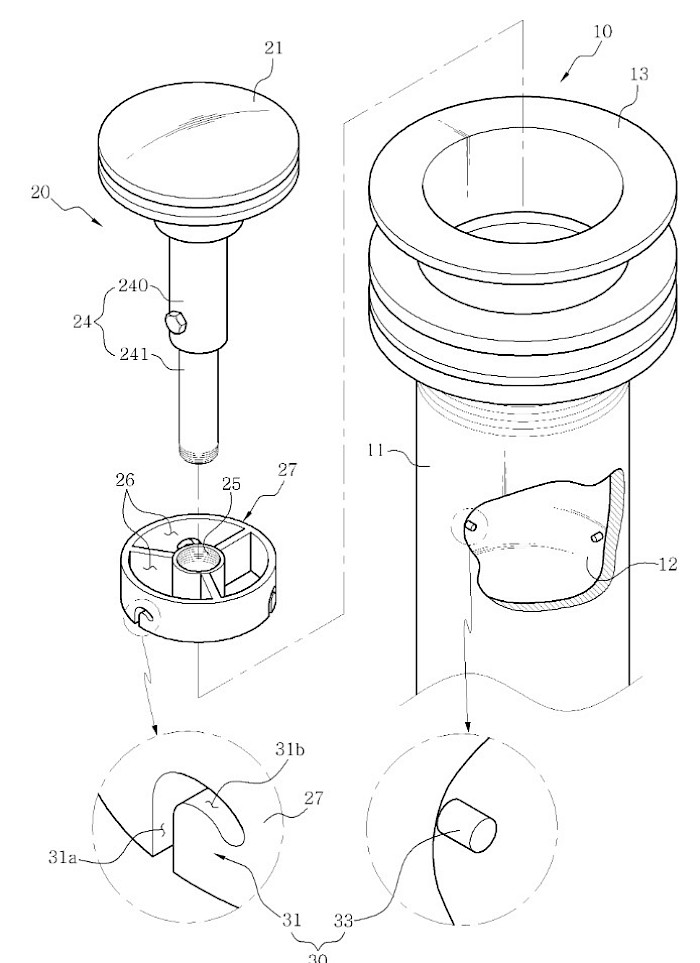
Lack of novelty over D3
D3 discloses, with reference to Fig. 22 and 24 of D3 (cf. column 8 in D3), a crossbar insert 94 (cf. M1) having crossbars 86 (cf. M4) connecting an annular ring 126 (cf. M2) to a hub 98 (cf. M3). The hub 98 may include a threaded aperture 102 for receiving a drain closure.
Thus, the crossbar insert 94 of D3 comprises all features M1 to M4 of claim 1 in EP'77.
Claim 1 of EP'77 is thus also not novel over D3.
Fig. 22 and Fig. 24 from D3
Effective delineation from the prior art
It appears that protection for a drain adapter is not inherently warranted.
Below is one way we believe to achieve effective differentiation from the cited prior art.
For example, it might be useful to designate the subject-matter of the invention not as the drain adapter per se, but as the combination of the drain adapter and the drain plug, if a functional indication is further defined with respect to the absorption of water-soluble substances in the drain plug.
At first glance, D1 seems to be able to fulfill such a function as well (see strainer basket 40 in Fig. 3 of D1). However, the strainer basket 40 is not designed to hold water-soluble substances. It is intended for use as a simple strainer (cf. [0021] in D1).
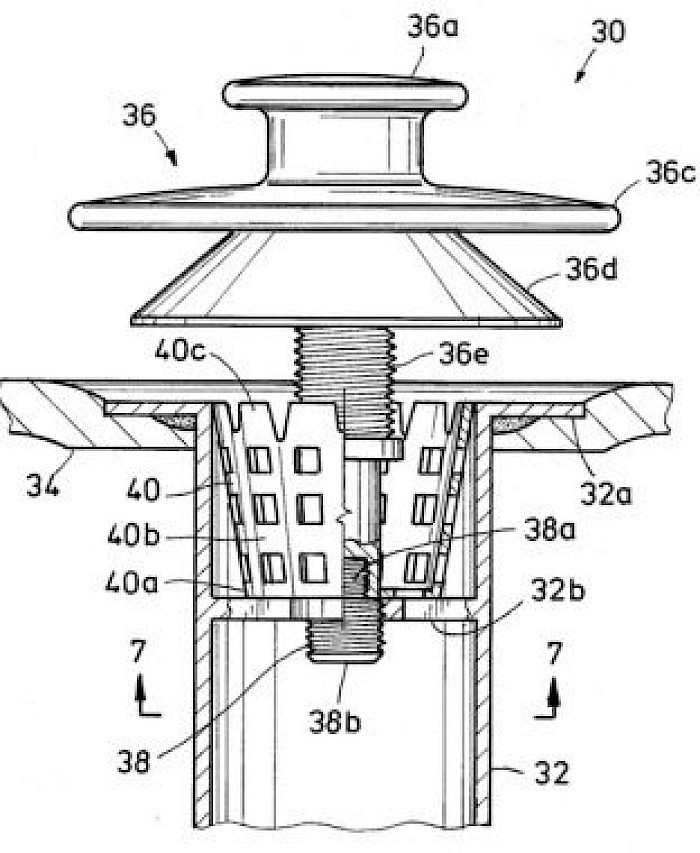
In D1 as the closest prior art, there is itself no other construction of the strainer basket 40 or reason for its construction other than the conical arrangement.
Basically, such a further development (water-soluble substance inside the drain plug) seems to lead away from the principle of a strainer basket 40 in D1, because a substance inside the strainer basket 40 of D1 would leave less space for dirt to be trapped and would therefore speak for an inventive step starting from D1.
Thus, the combination contemplated above could be inventive over the prior art cited in the search report.
Note: From the original application documents, there are also other possibilities for delimitation, e.g., in relation to only two spokes, the cross-section or the material. Thus, there remain further possibilities for delimitation from the cited prior art.
Conclusion
In many cases, an effective delineation from the cited prior art can be achieved by changing the designation of the subject-matter of the invention in conjunction with an indication of the function thereto. This is especially useful when the present invention has a new or improved function compared to the already known solutions.
By changing the designation of the subject-matter of the invention (in the case of the Drain Fairy: combination of adapter and drain plug), the invention can be clearly distinguished from the already known solutions, while the indication of the function serves to emphasize the novelty and distinctiveness of the invention (in the case of the Drain Fairy: the introduction of water-soluble substances in the drain plug).
Overall, this approach can promise a successful approach to protecting the rights to the invention.
Disclaimer: The above contribution reflects the personal opinion of the author. The assessments and statements made in the article do not constitute legal advice and are provided under exclusion of any liability. If you need an assessment of an individual case, please contact the author and/or the law firm KUHNEN & WACKER.
Further news and
publications from K&W

Start Your Career at K&W
and Become Part of Our Team
Are you ambitious and flexible? Do you like to work independently and are prepared to take responsibility? If so, K&W is your place to be.
Our HR manager Elwine Kaschner looks forward to receiving your application.

